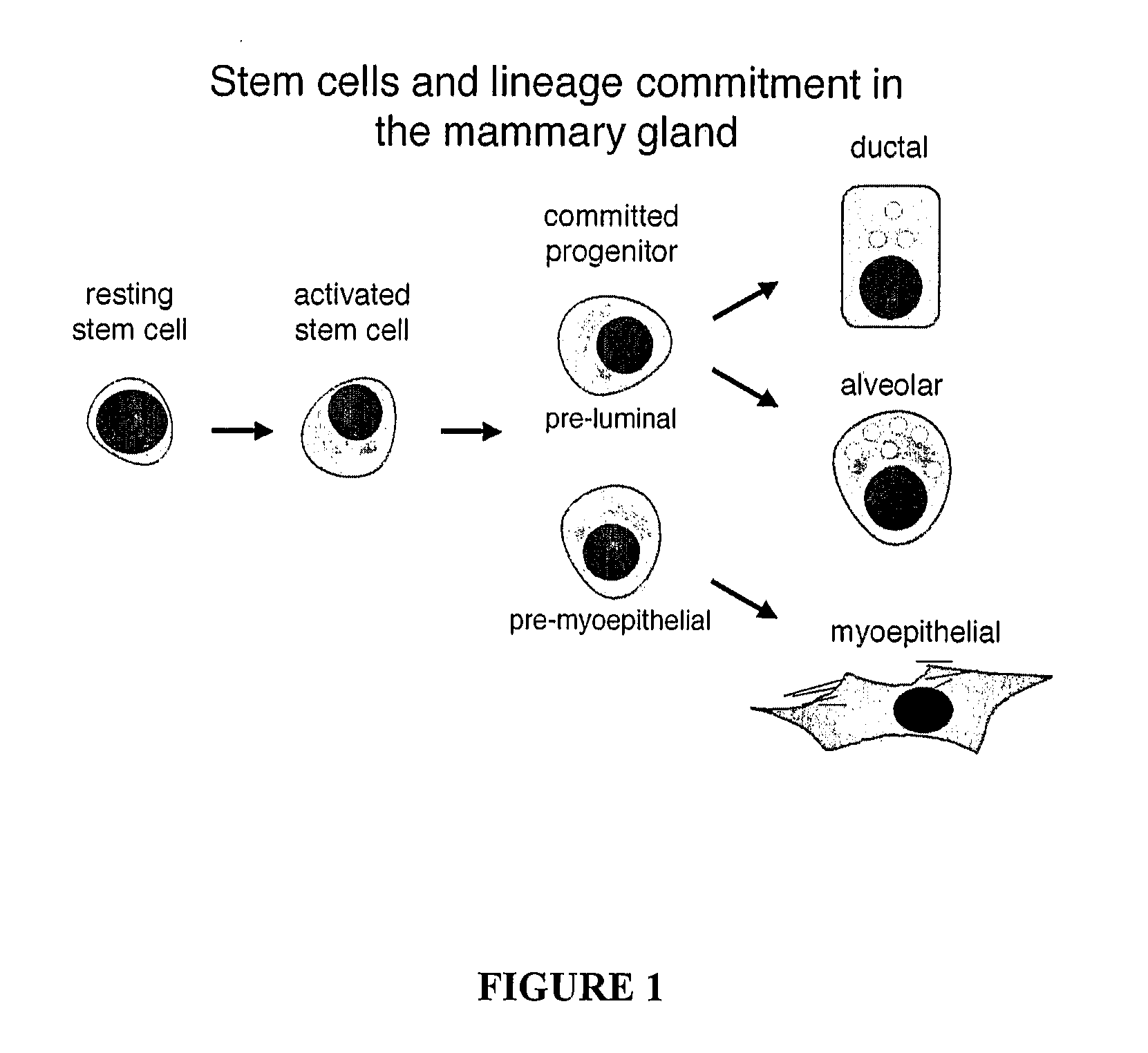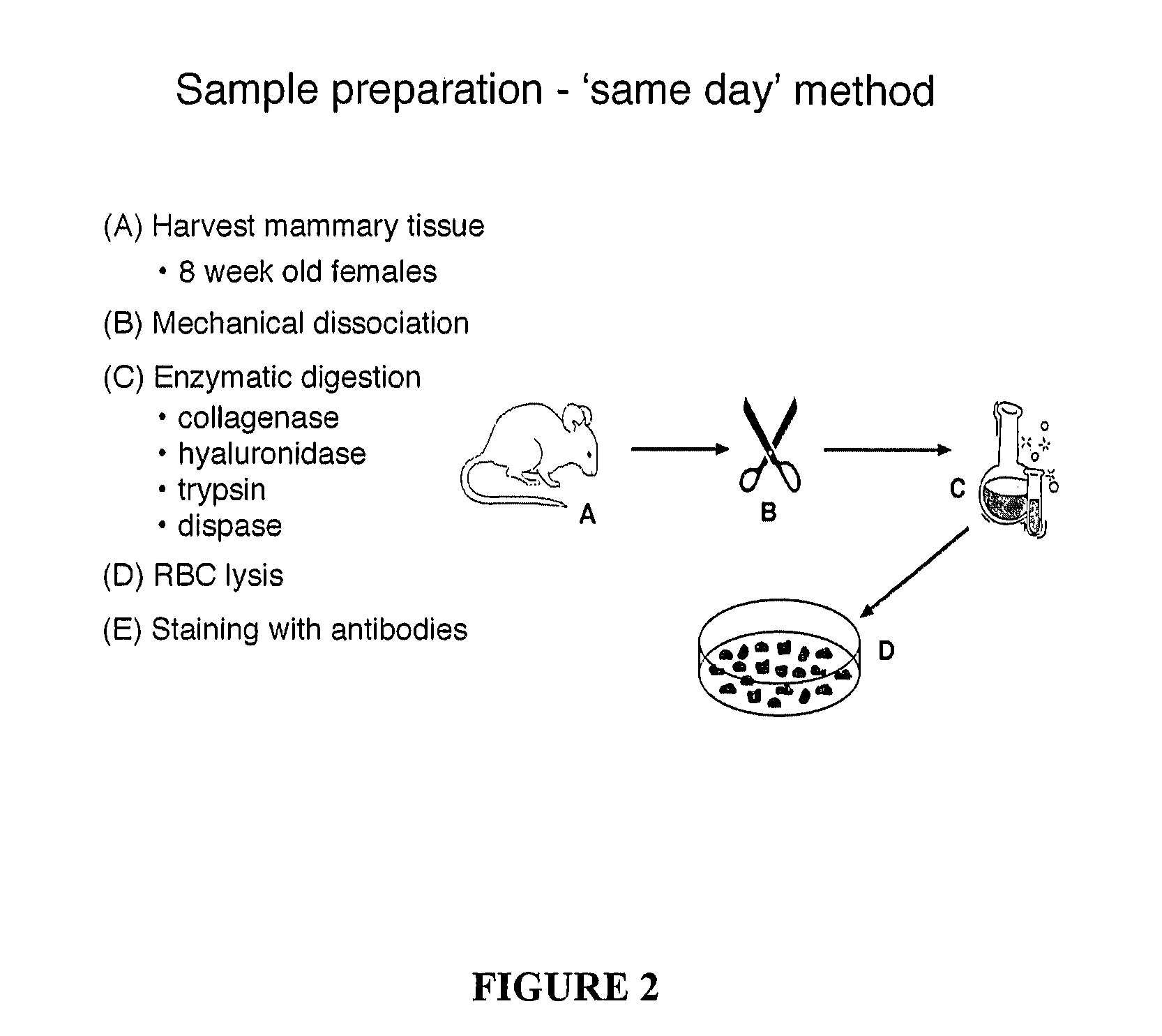Method Of Cell Isolation
a cell isolation and cell technology, applied in the field of cell isolation, can solve the problems of poor understanding and the inability to evaluate the comparative repopulating capacity of purified cell populations at limiting dilution, and achieve the effect of facilitating autologous cell transplant therapy and tissue regeneration
- Summary
- Abstract
- Description
- Claims
- Application Information
AI Technical Summary
Benefits of technology
Problems solved by technology
Method used
Image
Examples
example 1
General Experimental Procedures
Mammary Cell Preparation
[0106] The nature of mouse mammary epithelial stem cells was evaluated using the in vivo mammary epithelial cell transplantation approach described in Alvi et al., Breast Cancer Res 5:R1-R8, 2003. The protocol for mammary epithelial cell purification was optimised and is summarized in FIG. 2. It initially involved the harvesting of the 3rd, 4th (after first removing the visible lymph node) and 5th mammary glands from eight-week-old mice. The harvested glands were mechanically dissociated using a McIllwain tissue chopper and then enzymatically disrupted with 300 U / ml collagenase and 100 U / ml hyaluronidase in dissociation medium (DME-HAM, 5% v / v FCS, 5 μg / ml insulin, 500 ng / ml hydrocortisone 10 ng / ml EGF and 20 ng / ml cholera toxin) for one hour at 37° C., with forceful titurations every 20 minutes. The resulting organoid suspension was serially treated with 0.25% w / v trypsin / 1 mM EGTA for 1-2 minutes at 37° C. to disrupt cell-c...
example 2
Limiting Dilution Studies
[0115] To establish the frequency of mammary stem cells in a cell population, limiting dilution analysis of mammary repopulating capacity was performed. Limiting dilution analysis is a well-established method for determining the frequency of cells in a specific population that have a certain characteristic (in our case, the ability to form a mammary epithelial structure in vivo). It assumes that the cells in question have this characteristic independent of other cells in the suspension. In our method, decreasing numbers of cells transplanted should produce a progressively smaller proportion of positive outgrowths, such that there is a linear relationship between the log of the number of cells transplanted and the proportion of positive outgrowths. Statistical analysis of our repopulation data was performed using L-Calc software (Stem Cell Technologies, Vancouver, Canada).
[0116] The mammary repopulating cell frequency in the overall cell population was anal...
example 3
Flow Cytometric Analysis of Mammary Cell Preparation Stained with Hoechst33342
[0117] SP cells were identified in our freshly isolated mammary epithelial cell preparation using the Ho dye efflux assay. Prior to antibody staining, Ho dye was added to the cells at a concentration of 3 mg / mL and incubated at 37° C. for one hour. The presence of SP cells was confirmed by treatment of cells with verapamil, which has been shown to inhibit the BCRP1 / ABCG2 membrane transporter pump responsible for the efflux of Hoechst dye. SP cells accounted for approximately 1% of the cells in our mammary cell preparation (FIG. 5).
PUM
| Property | Measurement | Unit |
|---|---|---|
| time | aaaaa | aaaaa |
| temperature | aaaaa | aaaaa |
| volume | aaaaa | aaaaa |
Abstract
Description
Claims
Application Information
 Login to View More
Login to View More - R&D
- Intellectual Property
- Life Sciences
- Materials
- Tech Scout
- Unparalleled Data Quality
- Higher Quality Content
- 60% Fewer Hallucinations
Browse by: Latest US Patents, China's latest patents, Technical Efficacy Thesaurus, Application Domain, Technology Topic, Popular Technical Reports.
© 2025 PatSnap. All rights reserved.Legal|Privacy policy|Modern Slavery Act Transparency Statement|Sitemap|About US| Contact US: help@patsnap.com



